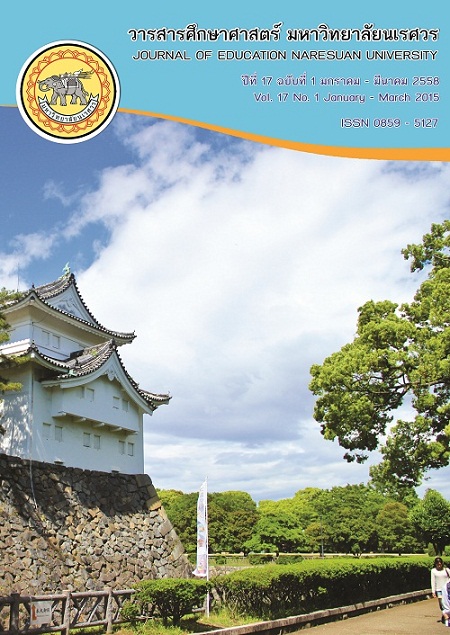กลยุทธ์การพัฒนาภาวะผู้นำของผู้บริหารสถานศึกษา สังกัดสำนักงานเขตพื้นที่การศึกษาประถมศึกษาตาก เขต 1 และ 2
Main Article Content
Abstract
บทคัดย่อ
การวิจัยครั้งนี้มีวัตถุประสงค์เพื่อ 1) ศึกษาภาวะผู้นำของผู้บริหารสถานศึกษา 2) ศึกษาสภาพปัญหา และปัจจัยที่เกี่ยวข้องกับการพัฒนาภาวะผู้นำของผู้บริหารสถานศึกษา 3) พัฒนากลยุทธ์การพัฒนาภาวะผู้นำของผู้บริหารสถานศึกษา 4) ประเมินกลยุทธ์การพัฒนาภาวะผู้นำของผู้บริหารสถานศึกษา เก็บรวบรวมข้อมูล โดยใช้แบบสอบถาม การสนทนากลุ่ม การสัมภาษณ์ การประชุมเชิงปฏิบัติการ และการสัมมนาอิงผู้เชี่ยวชาญ วิเคราะห์ข้อมูลโดยใช้ค่าความถี่ ค่าร้อยละ ค่าเฉลี่ย ค่าเบี่ยงเบนมาตรฐาน และการวิเคราะห์เนื้อหา
ผลการวิจัยพบว่า
1. ภาวะผู้นำของผู้บริหารสถานศึกษา โดยภาพรวมระดับการปฏิบัติภาวะผู้นำ อยู่ในระดับมาก
2. สภาพ ปัญหา และปัจจัยที่เกี่ยวข้องกับการพัฒนาภาวะผู้นำของผู้บริหารสถานศึกษา สรุปผลได้ดังนี้
2.1 สภาพการพัฒนาภาวะผู้นำของผู้บริหารสถานศึกษา 1) การพัฒนาตนเอง พบว่ามีการดำเนินการวางแผนการพัฒนาภาวะผู้นำของตนเอง มีการแลกเปลี่ยนเรียนรู้กับผู้อื่น และการศึกษาค้นคว้าหาความรู้ด้วยตนเอง หนังสือ ตำราต่างๆ มีการวิเคราะห์ผลการพัฒนาภาวะผู้นำเปรียบเทียบกับเป้าหมายและตัวชี้วัดความสำเร็จของแผนพัฒนา 2) การพัฒนาภาวะผู้นำจากหน่วยงานผู้บริหารสถานศึกษาได้รับการพัฒนาภาวะผู้นำจากหน่วยงาน ทั้งจากภายในและภายนอกหน่วยงานโดยการการฝึกอบรม/ประชุม/สัมมนา
2.2 ปัญหาการพัฒนาภาวะผู้นำของผู้บริหารสถานศึกษา 1) การพัฒนาตนเอง พบปัญหาเกี่ยวกับ ขาดการวิเคราะห์จุดเด่น จุดด้อยของตนเอง งบประมาณในการพัฒนาภาวะผู้นำไม่เพียงพอ ขาดการประเมินความก้าวหน้าในการพัฒนาภาวะผู้นำของตนเอง 2) การพัฒนาภาวะผู้นำจากหน่วยงาน พบปัญหาเกี่ยวกับ ขาดการสำรวจความต้องการในการพัฒนาภาวะผู้นำของผู้บริหาร โครงการ/กิจกรรมในการพัฒนาภาวะผู้นำมีความซ้ำซ้อน และขาดการนำผลพัฒนาภาวะผู้นำไปใช้จัดทำแผนในครั้งต่อไป
2.3 ปัจจัยที่เกี่ยวข้องกับการพัฒนาภาวะผู้นำของผู้บริหารสถานศึกษา สังกัดสำนักงานเขตพื้นที่การศึกษาประถมศึกษาตาก เขต 1 และ 2 พบว่า ปัจจัยภายในและปัจจัยภายนอกส่วนใหญ่อยู่ในระดับมาก มีปัจจัยภายใน 5 ด้าน ประกอบด้วย 1)ด้านผู้บริหารสถานศึกษา 2) ด้านครูผู้สอน 3) ด้านแหล่งเรียนรู้และวัสดุอุปกรณ์ 4) ด้านงบประมาณ 5) ด้านวิธีการพัฒนา ส่วนปัจจัยภายนอก 4 ด้าน ประกอบด้วย 1) ด้านเศรษฐกิจ 2)ด้านสังคม 3)ด้านเทคโนโลยี 4) ด้านนโยบายของรัฐบาลและหน่วยเหนือ
3. กลยุทธ์การพัฒนาภาวะผู้นำของผู้บริหารสถานศึกษา ประกอบด้วย 1 วิสัยทัศน์ 2 พันธกิจ 2 เป้าประสงค์ 2 ประเด็นกลยุทธ์ 8 กลยุทธ์ 9 ตัวชี้วัด และ 47 มาตรการ
4. ผลการประเมินกลยุทธ์การพัฒนาภาวะผู้นำของผู้บริหารสถานศึกษาสังกัดสำนักงานเขตพื้นที่การศึกษาประถมศึกษาตาก เขต 1 และ 2 พบว่า วิสัยทัศน์ พันธกิจ เป้าประสงค์ ประเด็นกลยุทธ์ กลยุทธ์ ตัวชี้วัด และมาตรการ มีความสอดคล้อง ความเหมาะสม ความเป็นไปได้อยู่ในระดับมาก และความเป็นประโยชน์ในระดับมากที่สุด
คำสำคัญ : กลยุทธ์/ การพัฒนา/ ภาวะผู้นำของผู้บริหารสถานศึกษา/ สำนักงานเขตพื้นที่การศึกษาประถมศึกษาตาก เขต 1 และ 2
Abstract
This research aimed to 1) study leadership of school administrators, 2) study condition, problems, and factors related to development of leadership of school administrators, 3) develop leadership developing strategies of school administrators, and 4) evaluate leadership developing strategies of school administrators. Data were collected by using questionnaires, having focus group discussion, conducting interview, workshop, and expert-based seminar. Data were analyzed by using frequency, percentage, mean, standard deviation, and content analysis.
Research results were as follows:
1. Leadership of school administrators in general was at a high level.
2. Condition, problems, and factors related to development of leadership of school administrators could be concluded as follows:
2.1 Leadership developing condition of school administrators. 1) As for self-development, the researcher found that school administrators planned self-development on leadership, shared knowledge with other people, searched knowledge from books and textbooks by themselves, and analyzed leadership developing results compared with goals and key performance indicators of development plans. 2) As for development of leadership by agencies, school administrators ’ leadership was developed in the training, the meeting and seminar organized by internal and external agencies.
2.2 Leadership developing problems of school administrators. 1) As for self-development, their strengths and weaknesses were not analyzed. Budget used for developing leadership was not sufficient. Progress in developing their leadership was not evaluated. 2) As for development of leadership by agencies, there was no survey of administrators’ need on development of leadership. Leadership developing projects/activities were complicated. Leadership developing results were not used for future planning.
2.3 Factors related to development of leadership of school administrators under Tak Primary Educational Service Area Office 1 and 2. The researcher found that most of internal factors and external factors were at the high level. Five internal factors consisted of 1) school administrators, 2) teachers, 3) learning centers, materials, and equipment, 4) budget, 5) development method. Four external factors consisted of 1) economy, 2) society, 3) technology, 4) policy of the government and responsible agency.
3. Leadership developing strategies of school administrators consisted of a vision, two missions, two goals, two strategic issues, eight strategies, nine indicators, and 47 measures.
4. After evaluating leadership developing strategies of school administrators under Tak Primary Educational Service Area Office 1 and 2, the researcher found that vision, missions, goals, strategic issues, strategies, indicators, and measures were consistent, suitable, possible at a high level and were useful at the highest level.
Keywords : Strategies/ Developing/ Leadership of school administrators/ Tak Primary Educational Service Area Office 1 and 2Article Details
The owner of the article does not copy or violate any of its copyright. If any copyright infringement occurs or prosecution, in any case, the Editorial Board is not involved in all the rights to the owner of the article to be performed.


